Vacuum pumps, a fundamental tool in many industries, are devices that remove gas molecules from a sealed volume to leave behind a partial vacuum. They come in a variety of types and sizes, each designed to meet specific needs. From laboratories to manufacturing plants, vacuum pumps play a crucial role in numerous applications.
The right vacuum pump can significantly enhance the efficiency and effectiveness of your operations. However, with the wide array of options available in the market, choosing the right one can be a daunting task. This article aims to provide a comprehensive guide to understanding, selecting, and maintaining vacuum pumps.
Choosing the right vacuum pump is not just about buying the most expensive or the most popular model. It’s about understanding your needs, the pump’s capabilities, and how well it can meet those needs. A well-chosen vacuum pump can save you time, money, and a lot of frustration in the long run.
Our Top Vacuum Pump Picks
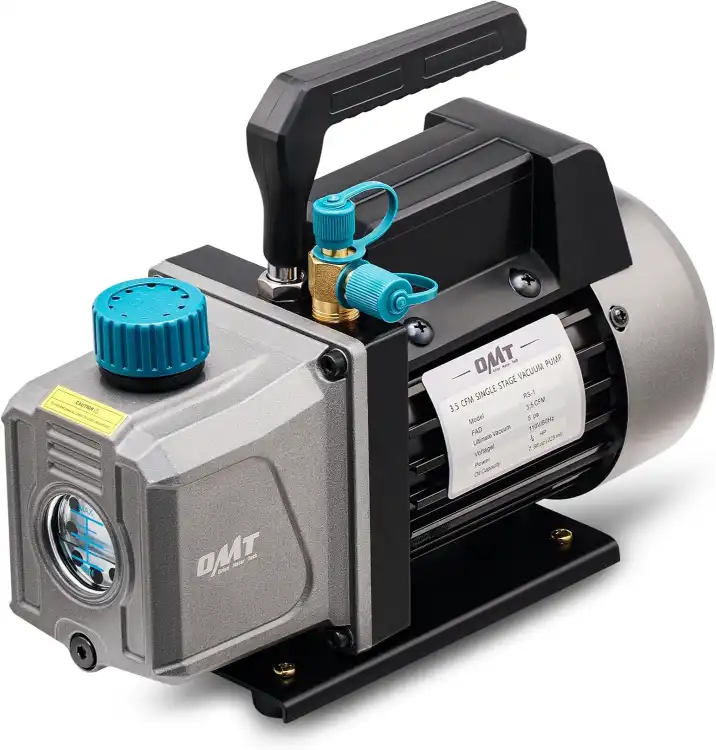
Orion Motor Tech Vacuum Pump
Check on AmazonKey Specs:
- Flow Rate: 3.5 cfm
- Motor Power: 1/4 hp all-copper
- Vacuum Level: 37.5 microns (5 Pa)
- Material: Aluminum alloy casing, copper motor
- Applications: Automotive HVAC, wine degassing, thermoforming, and more
The Orion Motor Tech Vacuum Pump is an excellent choice for efficient HVAC servicing, particularly for automotive AC systems. Powered by a durable 1/4 hp all-copper motor, it offers a 3.5 cfm flow rate, making quick work of evacuating refrigerant systems to 37.5 microns. Its sturdy aluminum alloy casing ensures long-lasting durability, while the easy-to-read oil sight glass and nonslip handle enhance user convenience. This pump is versatile and compatible with various refrigerants and applications, making it a reliable tool for automotive professionals.
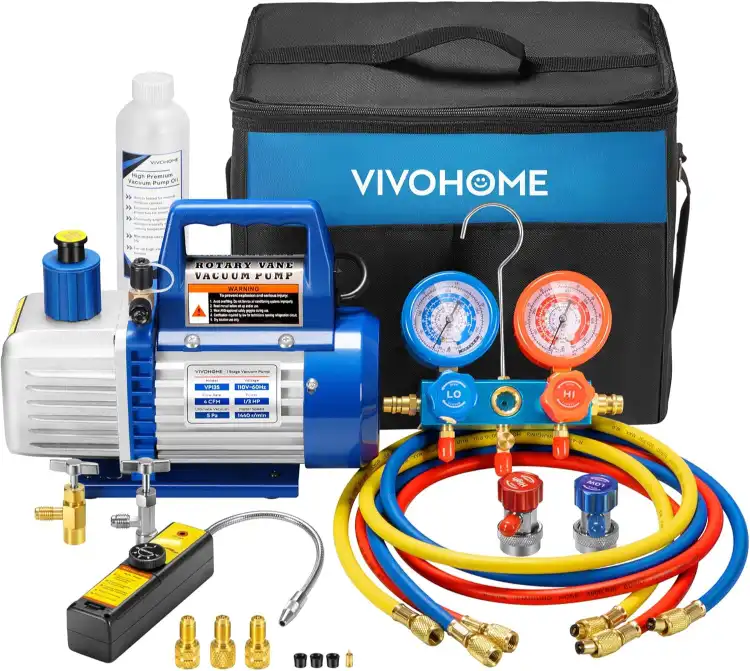
VIVOHOME 110V 1/3 HP 4CFM Single Stage Rotary Vane Air Vacuum Pump
Check on AmazonKey Specs:
- Flow Rate: 4 CFM
- Motor Power: 1/3 HP
- Material: Die-cast aluminum housing, anti-slip rubber base
- Included Accessories: Vacuum pump, oil, manifold gauge set, leak detector
- Compatibility: Works with R134a, R12, R22, R502, R410a systems
The VIVOHOME 110V 1/3 HP 4CFM Vacuum Pump Kit is an outstanding solution for automotive and HVAC maintenance. Featuring durable die-cast aluminum housing and an anti-slip rubber base, it provides solid performance and portability. The 4 CFM pump ensures quick evacuation of moisture from AC systems before refrigerant recharging. The ergonomic handle, cooling fan, and oil sight glass make it user-friendly. The included manifold gauge set, leak detector, and color-coded hoses make this kit a complete solution for precise refrigerant management.
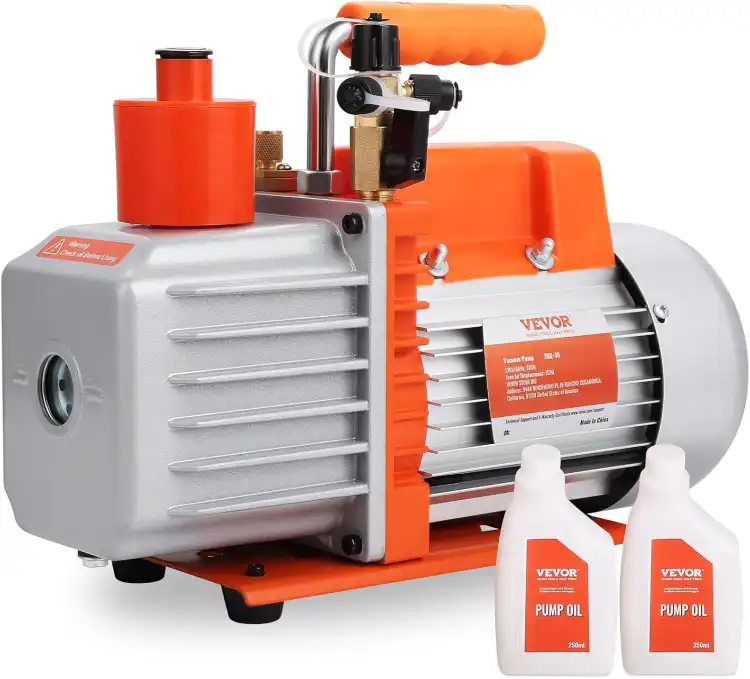
VEVOR 7 CFM Dual Stage HVAC Vacuum Pump
Check on AmazonKey Specs:
- Flow Rate: 7 CFM
- Ultimate Vacuum: 20 microns
- Motor Power: 1/2 HP pure copper motor
- Oil Capacity: 250 ml
- Compatibility: Works with R12, R22, R134a, R410a refrigerants
The VEVOR 7 CFM Dual Stage HVAC Vacuum Pump is a high-performance solution designed to handle tough tasks like HVAC repair and refrigeration maintenance. Its 7 CFM flow rate and 20-micron ultimate vacuum ensure quick and efficient evacuation. The 2-stage pump, with a 1/2 HP pure copper motor, offers excellent heat dissipation via a T-shaped heat sink and cooling fan, making it ideal for long work sessions. Its oil inlet system and ergonomic design make operation smooth and eco-friendly, with reduced emissions and noise.
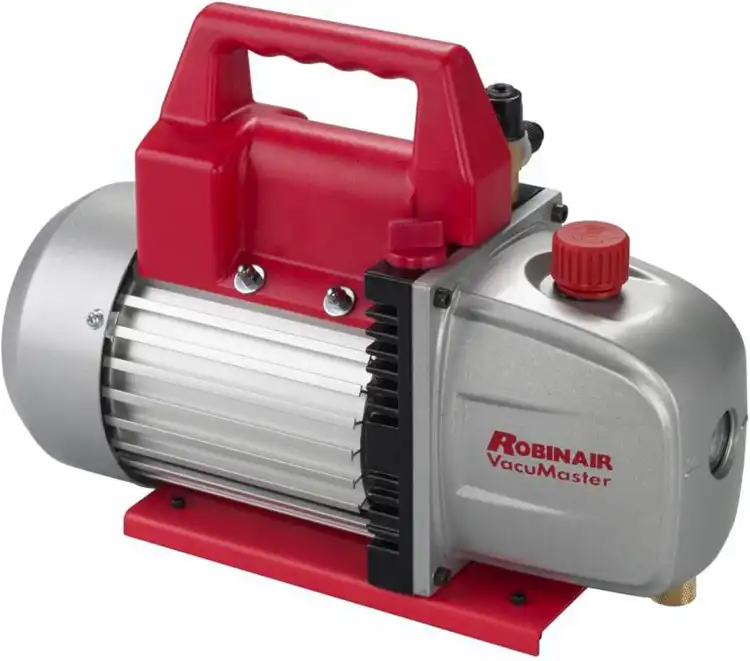
Robinair (15500) VacuMaster Economy Vacuum Pump
Check on AmazonKey Specs:
- Flow Rate: 5 CFM
- Ultimate Vacuum: 35 microns
- Motor Power: 1/2 HP thermally protected motor
- Oil Capacity: 7.5 ounces
- Inlet Fittings: 1/4 inch MFL & 3/8 inch ACME, 3/8 inch FFL x 1/2 inch ACME adapter
The Robinair (15500) VacuMaster Economy Vacuum Pump is a durable, high-efficiency tool for air conditioning and refrigeration service. With a 2-stage rotary vane design and 5 CFM free air displacement, it ensures excellent performance, achieving a factory-rated vacuum of 35 microns. The 1/2 HP motor is thermally protected for reliability, and the vacuum pump features an easy-to-read sight glass, oil fill port, and an angled drain valve for easy maintenance. The pump’s aluminum fins help with rapid heat dissipation, ensuring extended use.
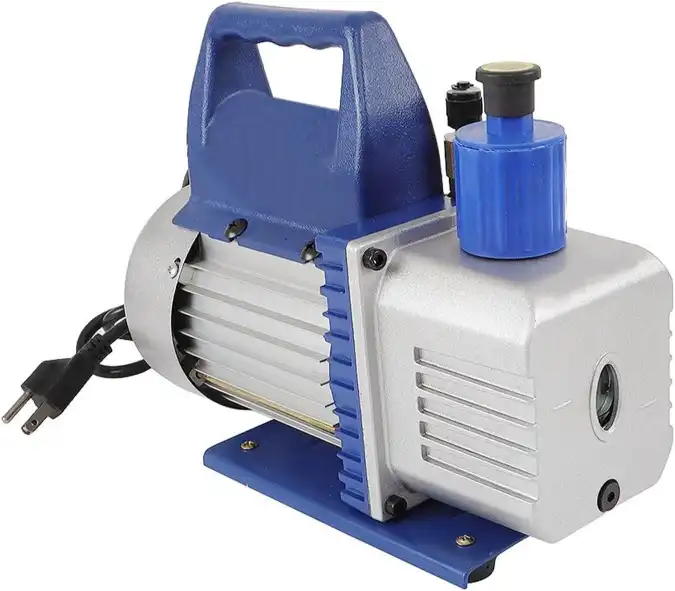
findmall 110V 4.5CFM 1/3HP Single Stage Air Vacuum Pump
Check on AmazonKey Specs:
- Flow Rate: 4.5 CFM
- Motor Power: 1/3HP thermal motor
- Voltage: 110V/60 Hz
- Design: Compact, lightweight, and portable
- Application: Ideal for R134a, R12, R22, and R502 systems
The findmall Vacuum Pump 110V 4.5CFM 1/3HP Single Stage Air Vacuum Pump is an efficient tool designed for maintaining R134a, R12, R22, and R502 air conditioning systems. With a 4.5 CFM flow rate and a 1/3HP motor, it offers reliable performance for both commercial and household applications. The aluminum shell ensures durability, while the built-in heat dissipation ports provide quick cooling to prevent overheating during long operations. Its compact and lightweight design makes it easy to transport and store.
Understanding Vacuum Pumps
A vacuum pump is a device that removes gas molecules from a sealed volume, creating a vacuum. They are used in a wide range of applications, from air conditioning systems to vacuum cleaners. They are also used in scientific research and industrial processes, such as vacuum drying and vacuum filtration.
There are several types of vacuum pumps, including rotary vane pumps, diaphragm pumps, liquid ring pumps, scroll pumps, and turbomolecular pumps. Each type has its own unique mechanism and is suited for different applications. For example, rotary vane pumps are commonly used in automotive applications, while turbomolecular pumps are used in high-vacuum applications in the field of physics.
Vacuum pumps are used in a variety of applications. In the industrial sector, they are used in manufacturing processes such as vacuum drying, vacuum coating, and vacuum impregnation. In the scientific field, they are used in laboratories for experiments that require low-pressure environments. They are also used in the medical field for applications such as radiotherapy, radiosurgery, and radiopharmacy.
Factors to Consider When Buying a Vacuum Pump
The first factor to consider when buying a vacuum pump is its purpose. What will you be using the pump for? Different applications require different types of pumps. For example, if you need a pump for a high-vacuum application, a turbomolecular pump would be a good choice. On the other hand, if you need a pump for a low-vacuum application, a rotary vane pump would be more suitable.
The performance of the pump is another important factor to consider. This includes the pump’s vacuum level, pumping speed, and power requirements. You should also consider the pump’s durability and reliability. A good vacuum pump should be able to operate continuously for long periods without breaking down.
The cost of the pump is also an important consideration. While it’s true that you get what you pay for, it’s also true that there’s no need to pay for features you don’t need. Therefore, it’s important to understand what features are important for your application and choose a pump that offers those features at a reasonable price. Additionally, consider the size and weight of the pump, especially if space is a concern.
Detailed Analysis of Vacuum Pump Types
Rotary vane vacuum pumps are among the most common types of vacuum pumps. They work by using a rotating mechanism to create a vacuum. These pumps are known for their durability and ability to create a high vacuum level. However, they require regular maintenance and can be noisy.
Diaphragm vacuum pumps use a diaphragm to create a vacuum. These pumps are known for their quiet operation and low maintenance needs. However, they are not suitable for high-vacuum applications. Liquid ring vacuum pumps use a liquid ring to create a vacuum. These pumps are known for their ability to handle wet or corrosive gases. However, they require a cooling liquid to operate.
Scroll vacuum pumps use a scroll mechanism to create a vacuum. These pumps are known for their quiet operation and high vacuum level. However, they are not suitable for handling wet or corrosive gases. Turbomolecular vacuum pumps use a high-speed rotor to create a vacuum. These pumps are known for their high vacuum level and are commonly used in high-vacuum applications. However, they are expensive and require a backing pump to operate.
Understanding Vacuum Pump Specifications
The vacuum level is a measure of how much gas is removed from the sealed volume. It is usually expressed in units of pressure, such as Pascals or Torr. The vacuum level you need depends on your application. For example, high-vacuum applications require a high vacuum level, while low-vacuum applications require a lower vacuum level.
The pumping speed is a measure of how quickly the pump can remove gas from the sealed volume. It is usually expressed in units of volume per time, such as cubic feet per minute or liters per second. The pumping speed you need depends on the size of the volume you need to evacuate and how quickly you need to evacuate it.
The power requirements of a vacuum pump depend on its type and size. For example, a large rotary vane pump requires more power than a small diaphragm pump. The maintenance needs of a vacuum pump also depend on its type. For example, rotary vane pumps require regular oil changes, while diaphragm pumps require little to no maintenance.
Top Vacuum Pump Brands
There are many vacuum pump brands on the market, each offering a range of models with different features and specifications. Some of the top brands include Edwards, Leybold, Pfeiffer, and Agilent. These brands are known for their quality, reliability, and wide range of products.
When comparing vacuum pump brands, it’s important to consider factors such as the brand’s reputation, the quality of its products, and the level of customer service it provides. It’s also important to compare the features and specifications of different models to find the one that best meets your needs.
While the brand is an important factor to consider, it’s also important to remember that the best vacuum pump for you is the one that best meets your specific needs, regardless of the brand. Therefore, it’s important to understand your needs and compare different models based on those needs, rather than simply choosing a pump based on its brand.
Tips for Maintaining a Vacuum Pump
Regular cleaning and inspection are crucial for maintaining a vacuum pump. Over time, dust and debris can accumulate in the pump, reducing its performance and potentially causing damage. Therefore, it’s important to clean the pump regularly and inspect it for signs of wear and tear.
Proper lubrication is also important for maintaining a vacuum pump. Some types of pumps, such as rotary vane pumps, require regular oil changes. The oil not only lubricates the moving parts of the pump but also helps to seal the pump and remove heat from the pump.
Regular replacement of worn-out parts is another important part of maintaining a vacuum pump. Over time, parts such as seals and bearings can wear out and need to be replaced. Regular replacement of these parts can help to prevent breakdowns and extend the life of the pump.
Conclusion
In conclusion, choosing the right vacuum pump involves understanding your needs, the different types of pumps, and the factors to consider when buying a pump. This includes the purpose of the pump, its performance, durability, cost, and size. It’s also important to understand the specifications of a vacuum pump, including its vacuum level, pumping speed, power requirements, and maintenance needs.
There are many vacuum pump brands on the market, each offering a range of models with different features and specifications. When choosing a pump, it’s important to compare these features and specifications to find the one that best meets your needs. Regular maintenance, including cleaning, lubrication, and replacement of worn-out parts, is also crucial for keeping your vacuum pump in good working condition.
Choosing the right vacuum pump can significantly enhance the efficiency and effectiveness of your operations. With the right knowledge and understanding, you can make an informed decision and choose a vacuum pump that will serve you well for many years to come.
FAQs
What is a vacuum pump?
A vacuum pump is a device that removes gas molecules from a sealed volume, creating a vacuum.
What are the different types of vacuum pumps?
There are several types of vacuum pumps, including rotary vane pumps, diaphragm pumps, liquid ring pumps, scroll pumps, and turbomolecular pumps.
What factors should I consider when buying a vacuum pump?
Factors to consider when buying a vacuum pump include its purpose, performance, durability, cost, and size.
How do I maintain a vacuum pump?
Regular maintenance of a vacuum pump includes cleaning, lubrication, and replacement of worn-out parts.
